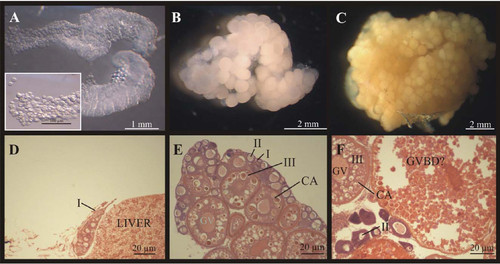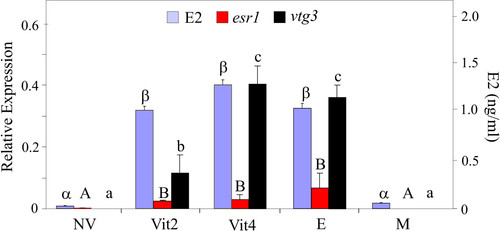- Title
-
Revealing genes associated with vitellogenesis in the liver of the zebrafish (Danio rerio) by transcriptome profiling
- Authors
- Levi, L., Pekarski, I., Gutman, E., Fortina, P., Hyslop, T., Biran, J., Levavi-Sivan, B., and Lubzens, E.
- Source
- Full text @ BMC Genomics
|
Ovaries from zebrafish (Danio rerio). The top panels show ovaries from non-vitellogenic females (A), 2-month old (B) and 4-month old (C) females and the corresponding histological sections are shown in lower panels (D, E and F, respectively). A) A non-vitellogenic ovary containing transparent Stage I oocytes, shown at a higher magnification in the insert. B) A vitellogenic ovary collected from a 2-month old female. C) A vitellogenic ovary collected from a 4-month old female. D) Histological section of a non-vitellogenic ovary (I) and liver. E) A cross-section of an ovary from a 2-month old female showing oocytes at Stages I, II and III with cortical alveoli (CA). F) A cross-section of an ovary from a 4-month old female showing oocytes at Stages II and III and one oocyte possibly displaying germinal vesicle breakdown (GVBD). Cortical alveoli (CA) and the germinal vesicle (GV) are clearly shown in stage III oocytes. |
|
Plasma levels of E2 and expression ratios of esr1 and vtg3 tested by RT-PCR. Gene expression levels were normalized to ef1a and expressed as Mean +SD (n = 3 pools). The letters ± and β indicate significant differences in the E2 levels. The letters A, B and a, b, c denote significantly different expression levels of esr1 and vtg3, respectively. E- E2-treated males, Vit2 or Vit4- 2- or 4-month old vitellogenic females, respectively, NV- Non-vitellogenic females, M- control males. EXPRESSION / LABELING:
|


